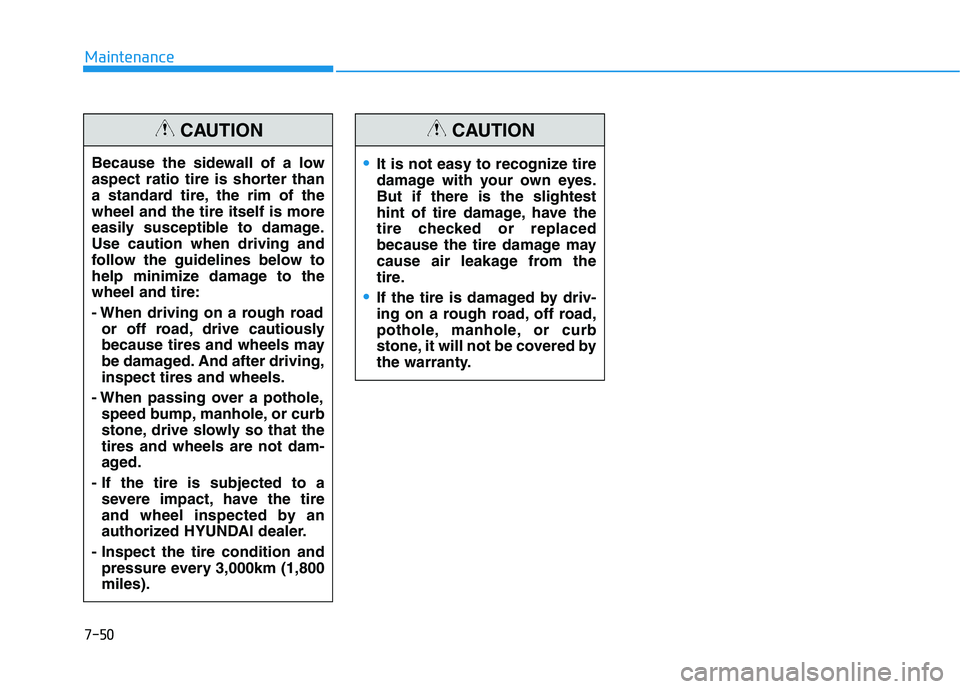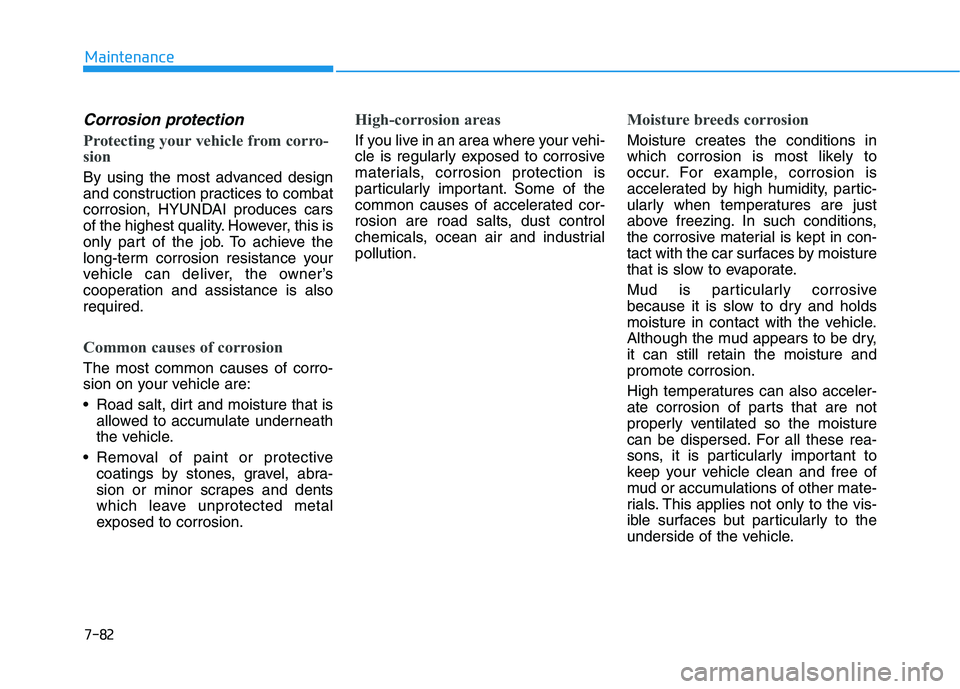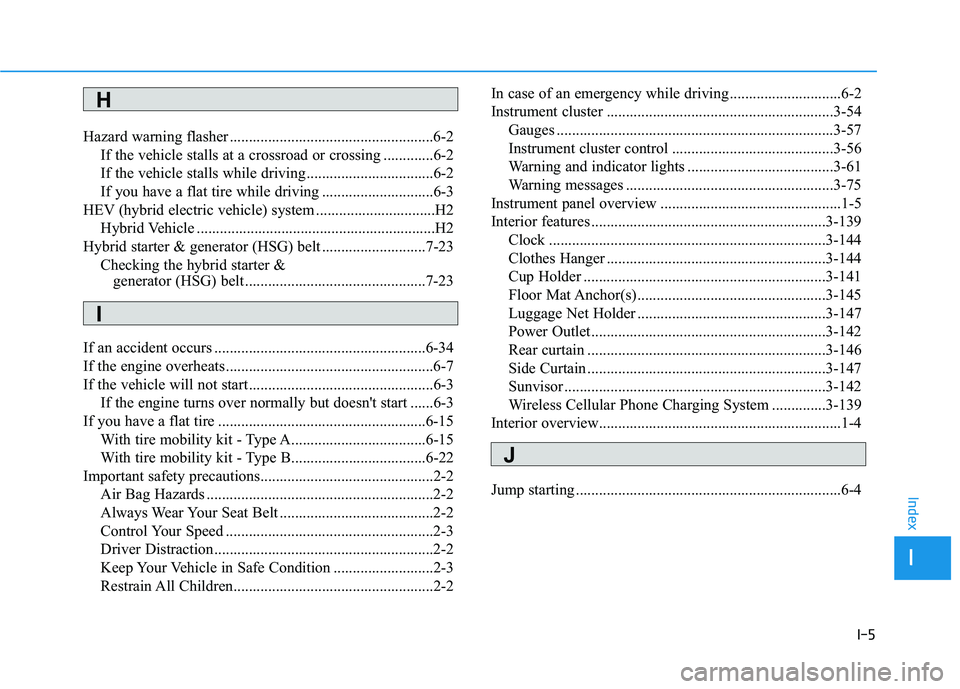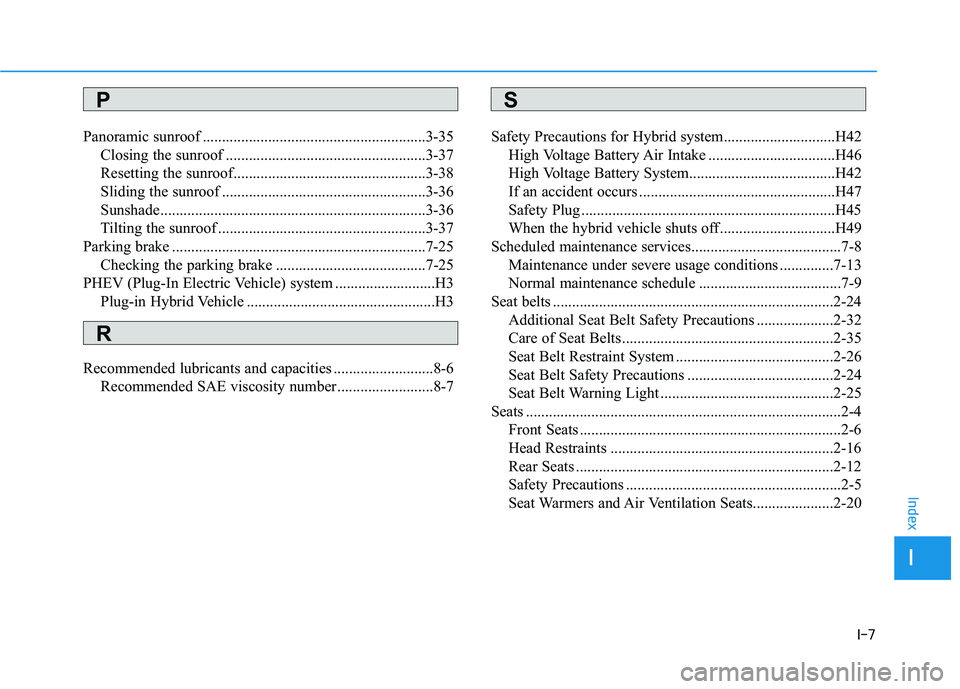2019 HYUNDAI SONATA HYBRID air condition
[x] Cancel search: air conditionPage 488 of 546

7-50
Maintenance
Because the sidewall of a low
aspect ratio tire is shorter than
a standard tire, the rim of thewheel and the tire itself is more
easily susceptible to damage.Use caution when driving and
follow the guidelines below to
help minimize damage to thewheel and tire:
- When driving on a rough roador off road, drive cautiously
because tires and wheels may
be damaged. And after driving,inspect tires and wheels.
- When passing over a pothole, speed bump, manhole, or curb
stone, drive slowly so that thetires and wheels are not dam-
aged.
- If the tire is subjected to a severe impact, have the tire
and wheel inspected by an
authorized HYUNDAI dealer.
- Inspect the tire condition and pressure every 3,000km (1,800miles).
CAUTION
It is not easy to recognize tire
damage with your own eyes.But if there is the slightest
hint of tire damage, have the
tire checked or replaced
because the tire damage may
cause air leakage from the
tire.
If the tire is damaged by driv-
ing on a rough road, off road,
pothole, manhole, or curb
stone, it will not be covered by
the warranty.
CAUTION
Page 520 of 546

7-82
Maintenance
Corrosion protection
Protecting your vehicle from corro-
sion
By using the most advanced design
and construction practices to combat
corrosion, HYUNDAI produces cars
of the highest quality. However, this is
only part of the job. To achieve the
long-term corrosion resistance your
vehicle can deliver, the owner’s
cooperation and assistance is alsorequired.
Common causes of corrosion
The most common causes of corro-
sion on your vehicle are:
Road salt, dirt and moisture that isallowed to accumulate underneath
the vehicle.
coatings by stones, gravel, abra-
sion or minor scrapes and dents
which leave unprotected metal
exposed to corrosion.
High-corrosion areas
If you live in an area where your vehi-
cle is regularly exposed to corrosive
materials, corrosion protection is
particularly important. Some of the
common causes of accelerated cor-
rosion are road salts, dust control
chemicals, ocean air and industrialpollution.
Moisture breeds corrosion
Moisture creates the conditions in
which corrosion is most likely to
occur. For example, corrosion is
accelerated by high humidity, partic-
ularly when temperatures are just
above freezing. In such conditions,
the corrosive material is kept in con-
tact with the car surfaces by moisture
that is slow to evaporate.
Mud is particularly corrosive
because it is slow to dry and holds
moisture in contact with the vehicle.
Although the mud appears to be dry,it can still retain the moisture andpromote corrosion.
High temperatures can also acceler-
ate corrosion of parts that are not
properly ventilated so the moisture
can be dispersed. For all these rea-
sons, it is particularly important to
keep your vehicle clean and free of
mud or accumulations of other mate-
rials. This applies not only to the vis-
ible surfaces but particularly to the
underside of the vehicle.
Page 527 of 546

7-89
7
Maintenance
Do not operate the engine in con-fined or closed areas (such as
garages) any more than what is
necessary to move the vehicle in orout of the area.
When the vehicle is stopped in an open area for more than a short
time with the engine running,
adjust the ventilation system (as
needed) to draw outside air into the
vehicle.
Never sit in a parked or stopped vehicle for any extended time with
the engine running.
When the engine stalls or fails to start, excessive attempts to restart
the engine may cause damage tothe emission control system.Operating precautions for cat-
alytic converters (if equipped)Your vehicle is equipped with a cat-
alytic converter emission control
device.
To prevent damage to the catalytic
converter and to your vehicle, take
the following precautions:
The exhaust system and cat-
alytic converter are very hot
during and immediately after
the engine has been running. To
avoid SERIOUS INJURY or
DEATH:
Do not park, idle, or drive the
vehicle over or near flamma-
ble objects, such as grass,
vegetation, paper, leaves, etc.
A hot exhaust system can
ignite flammable items under
your vehicle.
Keep away from the exhaust
system and catalytic convert-
er or you may get burned.
Also, Do not remove the heat
sink around the exhaust sys-
tem, do not seal the bottom of
the vehicle, and do not coat
the vehicle for corrosion con-
trol. It may present a fire risk
under certain conditions.
WARNING
Page 529 of 546

888
Specifications & Consumer information
8
Specifications & Consumer information
8
Dimensions ..............................................................8-2
Engine ......................................................................8-2
Bulb wattage ...........................................................8-3
Tires and wheels ....................................................8-4
Volume and weight ................................................8-5
Air conditioning system ........................................8-5
Recommended lubricants and capacities ...........8-6Recommended SAE viscosity number ..........................8-7
Vehicle identification number (VIN) ....................8-8
Vehicle certification label .....................................8-8
Tire specification and pressure label .................8-9
Engine number .......................................................8-9
Page 539 of 546

I-2
Accessing your vehicle .....................................................3-3
Immobilizer System .....................................................3-8
Smart Key.....................................................................3-3
Air bag - advanced supplemental restraint system .........2-47 Additional Safety Precautions ....................................2-69
Air Bag Warning Labels.............................................2-70
How Does the Air Bag System Operate? ...................2-53
Occupant Classification System (OCS) .....................2-58
SRS Care ....................................................................2-68
What to Expect After an Air Bag Inflates ..................2-57
Where Are the Air Bags? ...........................................2-49
Why Didn't My Air Bag Go Off in a Collision?........2-63
Air cleaner.......................................................................7-26
Filter replacement .......................................................7-26
Air conditioning system....................................................8-5
Appearance care..............................................................7-78 Exterior care ...............................................................7-78
Interior care ................................................................7-84
Automatic climate control system ................................3-119
Automatic heating and air conditioning ...................3-120
Manual heating and air conditioning .......................3-121
System maintenance .................................................3-131
System operation ......................................................3-129 Automatic Emergency Braking (AEB)...........................5-67
AEB front radar sensor ..............................................5-72
AEB warning message and system control................5-69
Limitations of the system ...........................................5-75
System malfunction ....................................................5-73
System setting and activation .....................................5-67
Automatic transmission ..................................................5-12 Automatic transmission operation..............................5-12
Good driving practices ...............................................5-17
Parking........................................................................5-17
Basic troubleshooting guide ...........................................6-35
Battery .............................................................................7-32 Battery recharging ......................................................7-33
For best battery service ..............................................7-33
Reset features .............................................................7-34
Before driving ...................................................................5-4
Before entering the vehicle ..........................................5-4
Before starting ..............................................................5-4
Blind Spot Detection system (BSD) ...............................5-45 BSD (Blind Spot Detection) / LCA (Lane Change Assist) .....................................5-46
Limitations of the system ...........................................5-52
RCTA (Rear Cross Traffic Alert) ...............................5-49
Brake fluid ......................................................................7-24 Checking the brake fluid level ...................................7-24
Index
A
B
Page 542 of 546

I-5
Hazard warning flasher .....................................................6-2
If the vehicle stalls at a crossroad or crossing .............6-2
If the vehicle stalls while driving .................................6-2
If you have a flat tire while driving .............................6-3
HEV (hybrid electric vehicle) system ...............................H2 Hybrid Vehicle ..............................................................H2
Hybrid starter & generator (HSG) belt ...........................7-23 Checking the hybrid starter & generator (HSG) belt ...............................................7-23
If an accident occurs .......................................................6-34
If the engine overheats ......................................................6-7
If the vehicle will not start ................................................6-3 If the engine turns over normally but doesn't start ......6-3
If you have a flat tire ......................................................6-15 With tire mobility kit - Type A...................................6-15
With tire mobility kit - Type B...................................6-22
Important safety precautions.............................................2-2
Air Bag Hazards ...........................................................2-2
Always Wear Your Seat Belt ........................................2-2
Control Your Speed ......................................................2-3
Driver Distraction.........................................................2-2
Keep Your Vehicle in Safe Condition ..........................2-3
Restrain All Children....................................................2-2 In case of an emergency while driving .............................6-2
Instrument cluster ...........................................................3-54
Gauges ........................................................................3-57
Instrument cluster control ..........................................3-56
Warning and indicator lights ......................................3-61
Warning messages ......................................................3-75
Instrument panel overview ...............................................1-5
Interior features .............................................................3-139 Clock ........................................................................3-144
Clothes Hanger .........................................................3-144
Cup Holder ...............................................................3-141
Floor Mat Anchor(s) .................................................3-145
Luggage Net Holder .................................................3-147
Power Outlet.............................................................3-142
Rear curtain ..............................................................3-146
Side Curtain ..............................................................3-147
Sunvisor ....................................................................3-142
Wireless Cellular Phone Charging System ..............3-139
Interior overview...............................................................1-4
Jump starting .....................................................................6-4
I
Index
H
I
J
Page 544 of 546

I-7
Panoramic sunroof ..........................................................3-35
Closing the sunroof ....................................................3-37
Resetting the sunroof..................................................3-38
Sliding the sunroof .....................................................3-36
Sunshade.....................................................................3-36
Tilting the sunroof ......................................................3-37
Parking brake ..................................................................7-25 Checking the parking brake .......................................7-25
PHEV (Plug-In Electric Vehicle) system ..........................H3 Plug-in Hybrid Vehicle .................................................H3
Recommended lubricants and capacities ..........................8-6 Recommended SAE viscosity number .........................8-7 Safety Precautions for Hybrid system.............................H42
High Voltage Battery Air Intake .................................H46
High Voltage Battery System......................................H42
If an accident occurs ...................................................H47
Safety Plug ..................................................................H45
When the hybrid vehicle shuts off ..............................H49
Scheduled maintenance services.......................................7-8
Maintenance under severe usage conditions ..............7-13
Normal maintenance schedule .....................................7-9
Seat belts .........................................................................2-24 Additional Seat Belt Safety Precautions ....................2-32
Care of Seat Belts .......................................................2-35
Seat Belt Restraint System .........................................2-26
Seat Belt Safety Precautions ......................................2-24
Seat Belt Warning Light .............................................2-25
Seats ..................................................................................2-4 Front Seats ....................................................................2-6
Head Restraints ..........................................................2-16
Rear Seats ...................................................................2-12
Safety Precautions ........................................................2-5
Seat Warmers and Air Ventilation Seats.....................2-20
I
Index
P
R
S